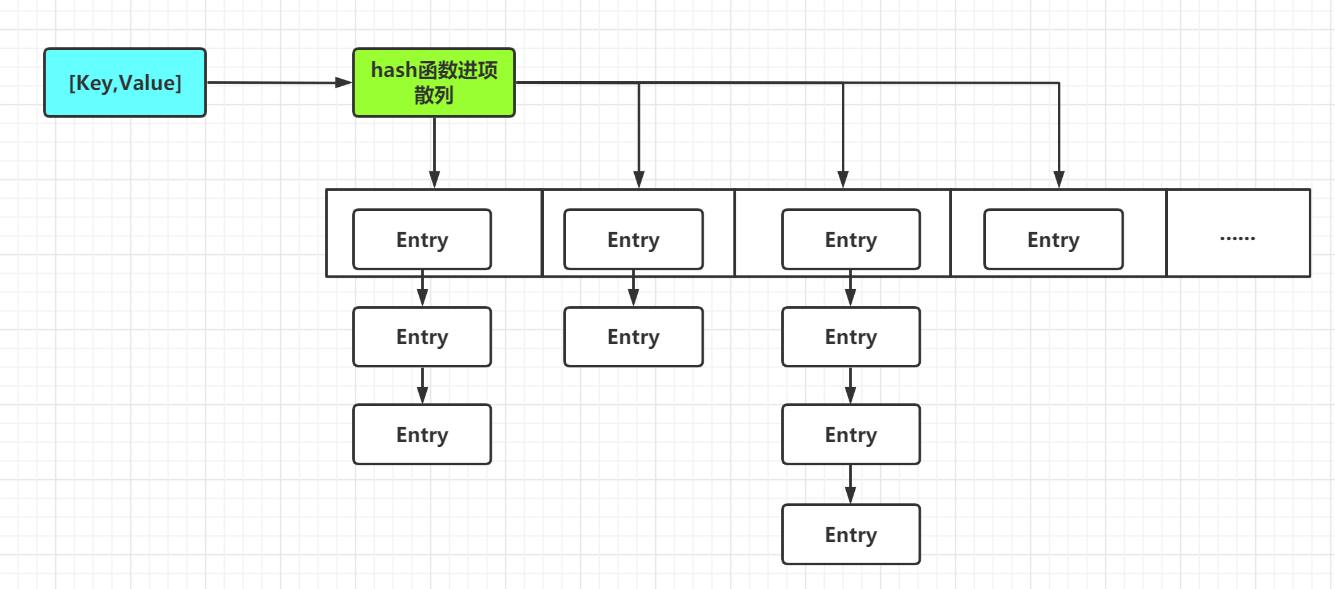实现一个简单的HashMap
朋友面试,遇到了一个问题,在没有提供HashMap API的情况下,怎么实现一个HashMap
这个问题,考察的无非是对HashMap的理解,考察的HashMap的底层结构
话不多说直接上图

构建思路
HashMap实现了太多的方法,我觉得在面试中不会让你一次性直接完成全部的方法,下面我们首先实现HashMap最基本的get和put方法,当然你要手撕HashMap的前提是,HashMap的源码已经了解,怎么个执行流程,如果不是请先补课。
1、先新建 16个 桶即 bucket(16是源码默认的,可以自定义),给桶分别标上 1~16 标号;(初始容量)
2、put 一个键值对之后,用 key 的 hash 值对 16 取余,结果肯定也是一个 1~16 范围内的数值,把这对键值对放到取余后的值对应的那个的桶里(注意,不可能为每一个 hash 值都创建一个桶,那样的话代价太大,这里只创建了16个桶,所以很有可能一个桶里放入多个键值对。如果偏巧那个桶里是空的,直接把 key、value 放进去,如果桶不为空,就要一个一个比对桶里原有的 key 是否和现在要放进去的 key 是同一个(即 hash 值相同且 equals 为 true),如果是同一个,那么就用新的 value 覆盖替换原来的 value 就行,如果遍历完了,没有一个相同的 key,那么就放到所有 key 的最后面(jdk1.8之后是放在最前面),这样有多个键值对的桶里就形成了一个链表结构,而多个桶之间是数组元素的关系,所以说 HashMap 就是数组+链表结构。
3、get 一个 key 的值,也是现根据 key 的 hash 对 16 取余,确定其在数组中的 index,然后判断 数组下标为 index 处是否为空,如果为空,则直接返回空(所以说:HashMap 无法判断 value 为空是 key 为空还是 不存在 key 的节点),否则遍历 index 处的节点,直到找到 key,返回其对应的 value。
代码实现
首先定义一个MyMap接口
1
2
3
4
5
6
7
8
9
10
11
12
13
14
15
16
17
18
19
20
21
22
23
24
25
26
27
28
29
30
| package com.bestrookie.mymap;
public interface MyMap <K,V>{
V put(K key ,V value);
V get(K key);
interface Entry<K,V>{
K getKey();
V getValue();
}
}
|
自定义一个MyHashMap类继承MyMap接口
1
2
3
4
5
6
7
8
9
10
11
12
13
14
15
16
17
18
19
20
21
22
23
24
25
26
27
28
29
30
31
32
33
34
35
36
37
38
39
40
41
42
43
44
45
46
47
48
49
50
51
52
53
54
55
56
57
58
59
60
61
62
63
64
65
66
67
68
69
70
71
72
73
74
75
76
77
78
79
80
81
82
83
84
85
86
87
88
89
90
91
92
93
94
95
96
97
98
99
100
101
102
103
104
105
106
107
108
109
110
111
112
113
114
115
116
117
| package com.bestrookie.mymap;
public class MyHashMap<K,V> implements MyMap<K,V>{
private static final int DEFAULT_INITIAL_CAPACITY =16;
private static final float DEFAULT_LOAD_FACTOR = 0.75f;
private float loadFactor = 0;
private int initCapacity = 0;
private Entry<K,V>[] table = null;
public MyHashMap(){
this.loadFactor = DEFAULT_LOAD_FACTOR;
this.initCapacity = DEFAULT_INITIAL_CAPACITY;
table = new Entry[this.initCapacity];
}
private int hash(K key){
int h;
return (key==null)? 0:Math.abs((h = key.hashCode())) ^ (h>>>16);
}
@Override
public V put(K key, V value) {
int index = hash(key) % initCapacity;
if (table[index] != null){
Entry<K,V> e = table[index];
Entry<K,V>e2 = null;
while (e !=null){
if (hash(e.key) == hash(key) && e.key.equals(key)){
e.value = value;
}
e2 = e;
e = e.next;
}
e2.next = new Entry<>(key,value,null,index);
}else{
Entry<K,V> e = new Entry<>(key,value,null,index);
table[index] = e;
}
return value;
}
@Override
public V get(K key) {
int index = hash(key) % initCapacity;
Entry<K,V> e = table[index];
if (e == null){
return null;
}
while (e != null){
if (e.key ==null && key ==null || hash(e.key) == hash(key) && e.key.equals(key)){
return e.value;
}
e = e.next;
}
return null;
}
class Entry<K,V> implements MyMap.Entry<K,V>{
K key;
V value;
Entry<K,V> next;
int index;
Entry(K key, V value, Entry<K,V> next,int index){
this.key = key;
this.value = value;
this.next = next;
this.index = index;
}
@Override
public K getKey() {
return key;
}
@Override
public V getValue() {
return value;
}
public Entry<K,V> getNext(){
return next;
}
}
}
|




